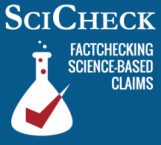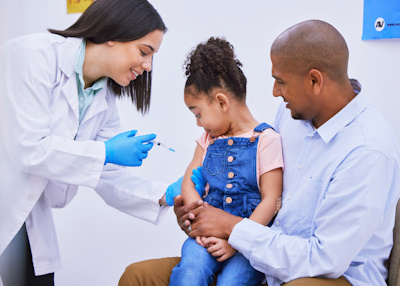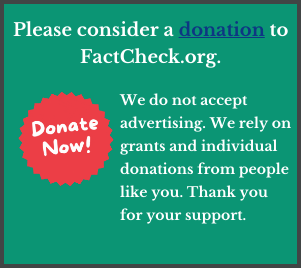SciCheck Digest
People who receive some vaccines that use live weakened viruses to stimulate a strong and lasting immune response sometimes release small amounts of those viruses outside of their bodies. That’s expected, and it doesn’t mean that they put vulnerable populations in “harm’s way,” as a post misleadingly suggests.
Full Story
Getting vaccinated is the safest way to get protection against certain diseases that can be dangerous and sometimes deadly. Multiple vaccines are recommended and especially important in children, the elderly and people with weakened immune systems and their close contacts, given that these groups are more susceptible to, and could suffer from complications from, preventable diseases.

Different types of vaccines work in different ways, but they all prompt the body to mount an immune response against a specific pathogen, which provides protection against a particular disease without a person having to get sick. Live attenuated vaccines contain a small amount of live virus that has been weakened. The live attenuated vaccines routinely recommended in the U.S. are the measles, mumps and rubella, or MMR vaccine; the varicella, or chickenpox, vaccine; the rotavirus vaccine; and the intranasal influenza vaccine.
With live attenuated vaccines, since the virus is weakened but not inactivated or “killed,” the virus can still replicate in the body, although much less so than a natural virus. This creates very strong and long-lasting immune protection, similar to the immunity stimulated by natural infection. It also means the weakened virus could be released or discharged outside the body, and, if there is a large amount of it, potentially transmitted to others. But that doesn’t mean that the vaccines are harmful or shouldn’t be used.
“When a pathogen replicates in the body, it can be shed in respiratory secretions or in stool. We call that shedding,” Benjamin Lopman, professor of epidemiology and environmental health at Emory University’s Rollins School of Public Health, told us in an email. “In some instances, it is possible for shed LAVs to be transmitted to other persons. However, since LAVs are safe, this generally does not present a problem,” he said, referring to live attenuated vaccines.
According to the Centers for Disease Control and Prevention, live attenuated vaccines “usually do not cause disease such as that caused by the wild form of the organism. When a live, attenuated vaccine does cause disease, it is usually much milder than the natural disease and is considered an adverse reaction to the vaccine.”
But a post published on Instagram gives the misleading impression that live attenuated vaccines are not safe and put vulnerable groups “in harm’s way.”
“Aren’t  supposed to protect the vulnerable people from disease?
supposed to protect the vulnerable people from disease?  can actually spread disease. Maybe’ you’ve heard of it, it’s known as shedding,” reads the caption of the Instagram post, which includes six slides about shedding and vaccines.
can actually spread disease. Maybe’ you’ve heard of it, it’s known as shedding,” reads the caption of the Instagram post, which includes six slides about shedding and vaccines.
The post continues by quoting a line from an article on live attenuated vaccines published in 2010 in Nature Biotechnology.
“Because LAVs (live attenuated viruses) are shed from  , they sometimes present a risk to un-
, they sometimes present a risk to un- individuals with impaired immunity,” reads the post, which incorrectly says the article was published by the National Institutes of Health.
individuals with impaired immunity,” reads the post, which incorrectly says the article was published by the National Institutes of Health.
The post continues: “So young children, pregnant women, immune compromised, the elderly…..that group of individuals we are told as those who choose not the  , that we are putting in harm’s way.”
, that we are putting in harm’s way.”
Raul Andino-Pavlovsky, professor of microbiology and immunology at the University of California, San Francisco, and one of the authors of the article cited in the Instagram post, told us in an email that not all live attenuated vaccines can be transmitted. “Most LAVs are not transmissible,” he wrote.
Moreover, he said, “it is crucial to emphasize that LAV viruses are attenuated in their pathogenicity. This means they replicate less effectively and do not infect tissues and organs where they cause disease.”
In other words, since the weakened virus reproduces less effectively than the naturally occurring virus would, less virus is shed, which makes it harder for someone else to get infected. And again, since the virus has been debilitated, it’s not able to produce symptoms in most people.
For this reason, in most cases, even people living with someone who is immunocompromised can — and in fact should — be vaccinated, including with live attenuated vaccines.

“Children in the homes of immune-compromised people can safely receive all routinely recommended vaccines. Adults in the home or in close contact with immune-compromised individuals should also be up to date on all routinely recommended vaccines, so they do not inadvertently expose the vulnerable person to vaccine-preventable diseases,” as the Children’s Hospital of Philadelphia Vaccine Education Center explains.
“Being a household contact of a pregnant woman or immunosuppressed person is usually not a contraindication to vaccination,” the CDC’s Pink Book, which is the agency’s guide to vaccines and vaccine-preventable diseases, says. “In fact, it is critical that healthy household contacts of pregnant women and immunosuppressed persons be vaccinated. Vaccination of healthy contacts reduces the chance that pregnant women and immunosuppressed persons will be exposed to vaccine-preventable diseases.”
Of the vaccines given in the U.S., the only vaccine that should not be given to people who are in close contact with immunocompromised people is the smallpox vaccine, which is only given in select circumstances. There are also some additional precautions that can be taken in a few other instances, as we’ll explain below. But the general notion that people should avoid vaccination because of shedding concerns is incorrect.
Some Vaccine Shedding Is Expected
The fact that some live attenuated vaccines shed is generally not cause for alarm.
Shedding is common after receiving a live attenuated influenza vaccine, according to the CDC, especially among younger people. Shedding is not the same as transmission, since transmission requires a larger amount of virus. Transmission of shed influenza vaccine viruses from vaccinated to unvaccinated people has been documented, according to the agency, “but has not been reported to be associated with serious illness,” the CDC explains. Close contacts of immunocompromised people can receive the live attenuated influenza vaccine, unless the person with immunocompetence is in a protective environment, according to the agency.
In a 2006 clinical study among 197 children, ages 9 months to 3 years, who received a vaccine or placebo, 80% of the vaccine recipients shed at least one vaccine strain, and one transmission was documented. The probability of transmission was calculated at 0.58%. “No clinically significant illness occurred among children who received vaccine or placebo or in the child to whom the vaccine virus was transmitted,” according to the study.
With the chickenpox, or varicella, vaccine, the manufacturer says transmission of the vaccine virus “may occur rarely between healthy vaccinees who develop a varicella-like rash and healthy susceptible contacts.” It adds that according to findings from a placebo-controlled trial with 416 placebo recipients who were household contacts of 445 vaccine recipients, “if vaccine virus transmission occurred, it did so at a very low rate and possibly without recognizable clinical disease in contacts.” A person who gets vaccinated against chickenpox and lives with someone who is immunocompromised does not need to take any extra precautions, the CDC says, unless they develop a rash. If that happens, the vaccinated person should stay away from the vulnerable person until the rash resolves.
Similarly, shedding and transmission have been detected with the rotavirus vaccine. According to the manufacturer, in the safety and efficacy trial, shedding in the stool was detected in 32 of 360 vaccine recipients after dose one, but in none of 249 vaccine recipients after dose two. Transmission was not evaluated in phase 3 studies, but has been observed.
For this reason, the CDC recommends that everyone in a household with an immunocompromised person take particular care to wash their hands after changing the diaper of an infant who received rotavirus vaccine. But again, this is not a good reason to not vaccinate a child in the first place.
As a 2008 review on viral shedding from rotavirus vaccines put it, “[s]ince the risk of vaccine transmission and subsequent vaccine-derived disease with the current vaccines is much less than the risk of wildtype rotavirus disease in immunocompromised contacts, vaccination should be encouraged.”
The main live vaccine for which viral shedding can be a real problem is the oral polio vaccine. The vaccine hasn’t been used in the U.S. since 2000, but other countries use it because it can prevent onward transmission of polio and is better for eradication efforts. Most of the time, viral shedding of the weakened vaccine virus is not a concern — and it can even be beneficial because it provides contact immunity or indirect vaccination, as experts told us for a previous story.
But sometimes the vaccine virus can change back into a more dangerous virus that can cause paralysis. This happens when the virus accumulates mutations after circulating for a long time in populations with low rates of vaccination or in immunocompromised people. This strain of vaccine-derived poliovirus can shed and infect others, putting unvaccinated people at risk of getting polio.
This only stresses the importance of vaccination among vulnerable groups. Polio was eliminated in the U.S. in 1979 thanks to widespread vaccination. And as part of the efforts to eradicate polio globally, scientists developed a new version of the oral polio vaccine, first rolled out in 2021, that is less likely to revert and cause vaccine-derived poliovirus outbreaks.
Live Attenuated Vaccine Contraindications
Although live attenuated vaccines are generally safe, they are contraindicated for certain groups and in certain instances.
They are not recommended for pregnant people due to a “theoretical risk of virus transmission to the fetus,” according to the CDC.
The CDC also says that live vaccines usually shouldn’t be given to severely immunocompromised people, such as people with leukemia, or people taking drugs that can cause severe immunosuppression, such as someone undergoing treatment for cancer. This is because these individuals may be unable to limit the replication of the weakened vaccine virus, which can lead to severe illness or death. Still, some immunocompromised people may receive some live attenuated vaccines safely, so patients should consult their doctors, since recommendations vary case by case.
Most live attenuated vaccines “can safely be given to vulnerable people with some exceptions,” Lopman, from Emory University, told us.
“Live attenuated vaccines have been used for as long as vaccines have existed. They are widely used globally and are generally safe,” Lopman said. “Severe reactions are extremely rare.”
Editor’s note: SciCheck’s articles providing accurate health information and correcting health misinformation are made possible by a grant from the Robert Wood Johnson Foundation. The foundation has no control over FactCheck.org’s editorial decisions, and the views expressed in our articles do not necessarily reflect the views of the foundation.
Sources
“Vaccines Types.” HHS. Accessed 11 Dec 2023.
“Epidemiology and Prevention of Vaccine-Preventable Diseases.” CDC. 18 Aug 2021.
“Vaccine (Shot) for Measles.” CDC. Accessed 11 Dec 2023.
“Vaccine (Shot) for Mumps.” CDC. Accessed 11 Dec 2023.
“Vaccine (Shot) for Rubella.” CDC. Accessed 11 Dec 2023.
“Vaccine (Shot) for Chickenpox.” CDC. Accessed 11 Dec 2023.
“Vaccine (Drops) for Rotavirus.” CDC. Accessed 11 Dec 2023.
“Live Attenuated Influenza Vaccine [LAIV] (The Nasal Spray Flu Vaccine).” CDC. Accessed 11 Dec 2023.
“Making Vaccines: How Are Vaccines Made?”. Children’s Hospital of Philadelphia, Vaccine Education Center. Accessed 11 Dec 2023.
“Altered Immunocompetence.” CDC. Accessed 11 Dec 2023.
“A Look at Each Vaccine: Smallpox Vaccine.” Children’s Hospital of Philadelphia, Vaccine Education Center. Accessed 11 Dec 2023.
McDonald, Jessica. “Poliovirus Found in New York City Wastewater, Not Tap Water.” FactCheck.org. 18 Aug 2022.
Lopman, Benjamin. Professor of epidemiology and environmental health at Emory University’s Rollins School of Public Health. Email sent to FactCheck.org. 5 Dec 2023.
Andino-Pavlovsky, Raul. Professor of microbiology and immunology at the University of California, San Francisco. Email sent to FactCheck.org. 5 Dec 2023.
“Infectious Diseases And Immune-Compromised People.” Children’s Hospital of Philadelphia, Vaccine Education Center. Spring 2020.
“Safety of Influenza Vaccines.” CDC. Accessed 11 Dec 2023.
“Varivax.” FDA. Accessed 11 Dec 2023.
“RotaTeq.” FDA. Accessed 11 Dec 2023.
“Vaccine-Derived Poliovirus.” CDC. Accessed 11 Dec 2023.
Jaramillo, Catalina. “No Scientific Basis for Vaccine ‘Shedding’ Claims.” FactCheck.org. 11 May 2021.
